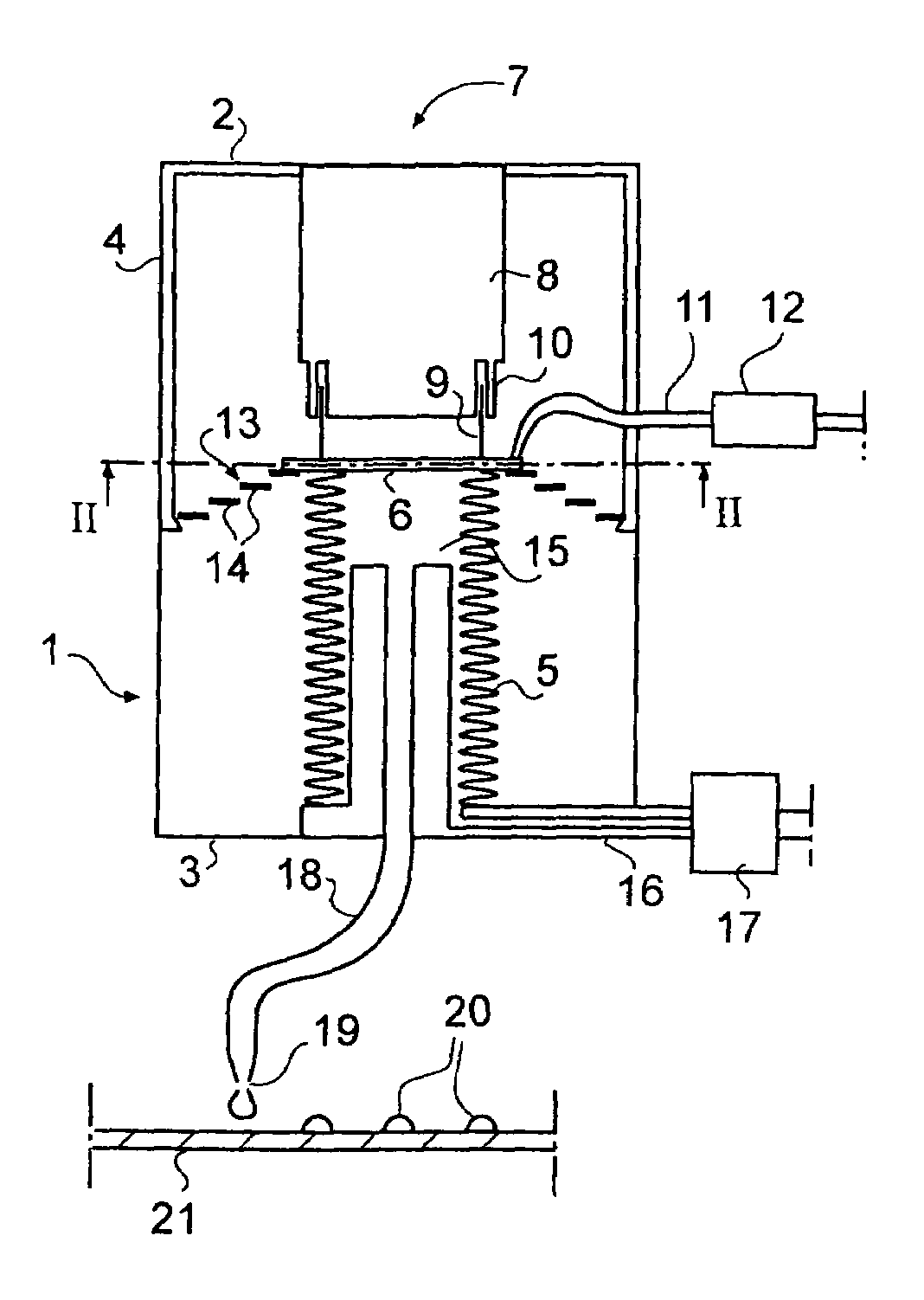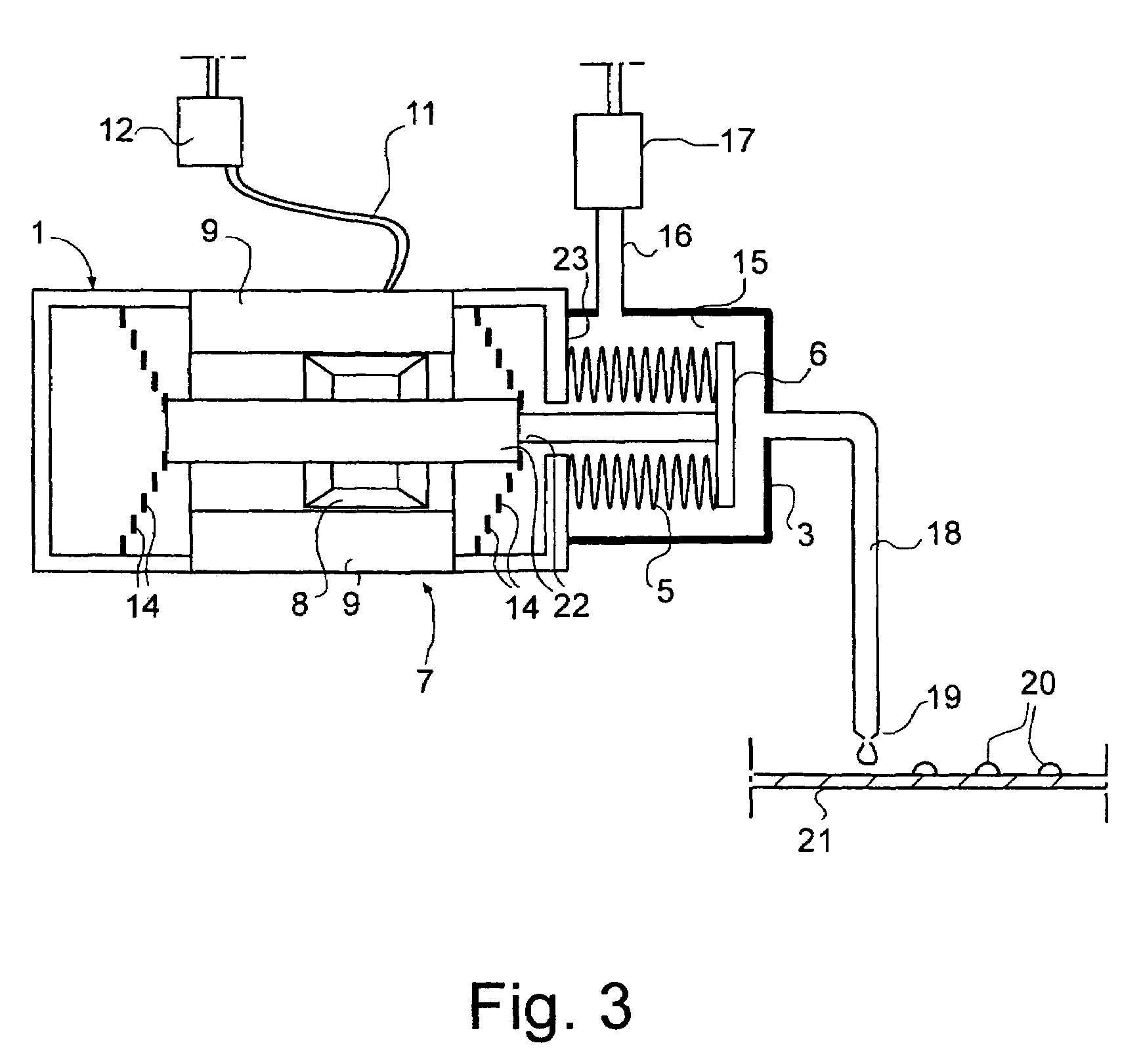Quantitative dosing of small amounts of liquids
a technology of liquid dosing device and small amount, which is applied in the direction of liquid/fluent solid measurement, container, measuring chamber, etc., can solve the problems of inability to ensure the reproducibility required in precise dosing of small liquid dose, the need for long piezo rod and high voltage source dangerous to the user, and the inability to accelerate the movement of servo motors. achieve the effect of speeding up the separation of droplets
- Summary
- Abstract
- Description
- Claims
- Application Information
AI Technical Summary
Benefits of technology
Problems solved by technology
Method used
Image
Examples
example 1
[0035]The invention was tested with nickel / cobalt-bellows defining an inner liquid space with a cross section of 50 mm2, the length of the path of the end of the bellows being 1.5 mm. The end of the bellows was moved with an acoustic coil LA08-10 producing an instantaneous compressing force of 0.9 kg, the coil being controlled by a 16 bit DA-converter using an Omega Engineering CIO-DAC02-16-controller card and the control program thereof. Effective dosing volume of the bellows is about 60 μl, and for said coil and DA converter, the smallest liquid volume that may be dosed is calculated to be about 1 nl. In the test, 20 doses of water having respectively a volume of 250 nl (250 μg), and 20 doses of water having respectively a volume of 15 nl (15 μg) were serially dosed directly into the receiving liquid having a volume of 2 ml, using liquid contact. Doses were determined by weighing the receiving liquid with a Mettler MT 5 balance before and after each dosing and by calculating the w...
example 2
[0036]In the test, nickel / cobalt bellows having a diameter of 12.5 mm were used, the highest dosing volume corresponding to the length of the path of the end of the bellows being about 100 μl. The bellows were moved by an acoustic coil LA13-12 controlled by a DA converter of Example 1. The orifice of the dosing tip was 0.35 mm.
[0037]The liquid to be dosed was a thick, heterogenous liquid reagent containing solid particles having a 7-fold viscosity compared to water.
[0038]Dosing was carried out as droplet dosing using the technique described above, first accelerating and then slowing down the movement of the liquid for sharp release of the droplet from the dosing tip. 20 liquid doses having respectively a volume of 1.5 μl were serially dosed, each time starting dosing by changing the magnitude of the electric current passed through he coil by a value corresponding to a volume change of the dosing space of 6 μl. The repelling force of the coil was thus 4-fold compared to the force alr...
example 3
[0039]Dilute dimethyl sulfoxide (DMSO) solution having a 2.5-fold viscosity compared to water was dosed with the dosing device of Example 2, using however smaller dosing tips. DMSO is a widely used solvent in drug research, dosing of which in small amounts has so far been difficult.
[0040]Using the droplet dosing technique of Example 2, 20 doses of the test solution, each having a volume of 250 nl, were serially dosed with a dosing tip having an orifice of 0.30 mm. The initial acceleration of the coil was over scaled 12-fold, the slowing down correction being carried out after 3 ms to the current magnitude corresponding with the dose volume. Doses were weighed with Mettler MT 5 balance, the standard deviation being 2 nl, that is less than 1% of the dose volume.
[0041]In the next serial dosing of 20 doses, the dose volume was 30 nl, and the orifice of the dosing tip was 0.24 mm, the procedure being otherwise the same as above. The standard deviation of the weighed doses was 3 nl, or 10...
PUM
 Login to View More
Login to View More Abstract
Description
Claims
Application Information
 Login to View More
Login to View More - R&D
- Intellectual Property
- Life Sciences
- Materials
- Tech Scout
- Unparalleled Data Quality
- Higher Quality Content
- 60% Fewer Hallucinations
Browse by: Latest US Patents, China's latest patents, Technical Efficacy Thesaurus, Application Domain, Technology Topic, Popular Technical Reports.
© 2025 PatSnap. All rights reserved.Legal|Privacy policy|Modern Slavery Act Transparency Statement|Sitemap|About US| Contact US: help@patsnap.com



